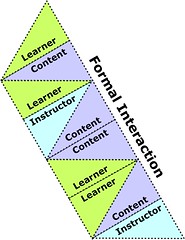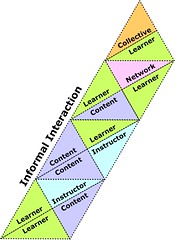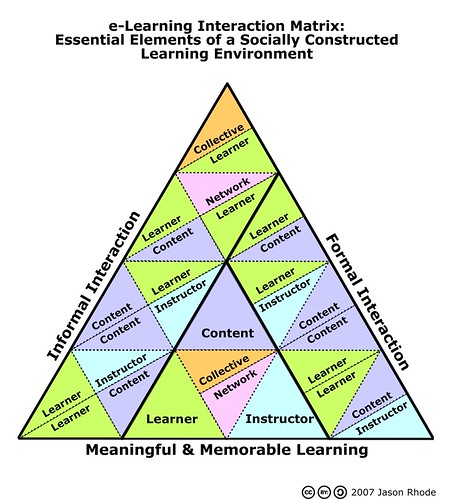As our attention during Week 6 of EDUMOOC turns to the notion of personal learning networks (PLNs), while there have been many fantastic diagrams and descriptions shared of what PLNs can consist of, I thought I’d share a little of my journey to development my own personal learning network (PLN) as well as the particular tools that I leverage today in building my own PLN.
My interest in the notion of personal learning networks began over a decade ago when as a graduate student I was looking for ways to share what I was learning with others as well as to form a process by which I could continue to build upon my learning after I completed my coursework. My thoughts at the outset were to chronicle my learning and scholarly activities in preparation for the eventual comprehensive exams and dissertation that I new were lying ahead of me but I also saw the opportunity to leverage the newer online technologies that were emerging to expand my own learning beyond the “walls” of the courses that I was taking.
I setup a blog, a rather new tool at that time, and began posting my own insights as well as sharing resources that I came across throughout my studies. Over the years, I’ve continued to build my own personal learning network and while I’m using different technologies and approaches now than when I first began, my underlying purpose remains the same … to continually expand and enrich my network of colleagues whom I can learn from and with as well as share knowledge I’m personally constructing with others.
In my teaching today, I encourage my students to see themselves as lifelong learners and to continually be developing their own individual personal learning networks so that long after they finish my course, they have opportunity to continue to grow and learn while learning from one another. How one
From a professional development angle, the concept of personal learning networks is a powerful one for faculty to grasp as in academia we are continually making new discoveries and through sharing our constructed knowledge, learning from one another. As I work with faculty, my encouragement to them is to continually be looking for ways to expand their horizon and learning network using whatever technology tools are the best fit for them.
My Personal Learning Network – August 2011
Here’s a glimpse at what my PLN consists of currently and the technology tools that at present I’m using.
- My Twitter Network. When Twitter first came on the scene in 2007, I was among the doubters who wondered how microblogging in such short bytes of information would ever be useful. I’ve since found Twitter to become my primary professional networking tool in building my PLN and keeping current on what is happening in my field. I tweet @jrhode for anyone who would like to connect with me there!
- My Shared Online Bookmarks (Diigo Library). As I come across online resources that to bookmark for access later, I use the Diigo social bookmarking tool and have found it to be a fantastic tool for not only creating my own personal online library of resources but also in sharing those resources with others. While I initially used Delicious as my social bookmarking tool, I’ve migrated to Diigo and use it instead because of the many added features and specific features for education, like private groups. I have linked my Diigo and Delicious accounts, so that anything I bookmark in Diigo, Diigo will automatically add to my Delicious library for anyone who is still following my Delicious bookmarks. Also, using Packrati, any links I post to Twitter are also bookmarked should I wish to access later.
- My Shared Academic Resources (CiteULike Library). As I find scholarly resources (ie: journal articles, books, etc.) that I may want to make use of in the future, I bookmark the item in my CiteULike library. CiteULike creates a unique URL for resources for each particular tag used in organizing the resources and users can share scholarly resources in a public or private group. I personally find CiteULike very useful when needing to share a list of scholarly sources I’ve bookmarked on a particular topic, such as social networking (click here).
- My Facebook Page. While I’m not all that active on Facebook, I do have many students and colleagues who are and would like to connect with me there. Instead of adding acquaintances and students as “friends” in my personal Facebook profile, I’ve setup a separate page at facebook.com/jasonrhodephd where students and colleagues can connect with me. I use Selective Tweets to post select updates from Twitter automatically to my Facebook page.
- My Google Reader. My RSS subscriptions to blogs and other news sites continues to be my other primary means for keeping current. The Reeder app on my Mac, iPhone, and iPad is currently my preferred way to read and share items from Google Reader. I star particular news items that I may want to come back to later and can easily search from within the app or the Google Reader directly.
- My Podcast Subscriptions. As an auditory learner with a 40 min. daily commute, podcasts are another tool for me to learn and keep current. I subscribe to a number of podcasts and listen to them to/from work. I prefer audio podcasts since I can speed the playback on my iPhone 2X.
- My Professional Association Listserv Subscriptions. I am subscribed to the listservs of several professional associations that I am a part of. Email still has a place in my PLN, even in 2011!
- My Personal Connections (Hashable). With the rise in Twitter, as I’ve met individuals at conferences or other gatherings, I’ve begun using the Hashable app to keep track of who I’m meeting and where. It’s the most recent addition to my PLN and the jury is still out on whether the tool will be around long-term or how long it will be useful. But, for now, it’s been a fantastic tool for helping solidify the connections I’m making with others.
There are other social networking tools that I do use, but these are the ones that have become the primary means by which I am continuing to build my PLN. I’d love to hear what tools or approaches are working for you in building your PLN.
~ Jason @jrhode







